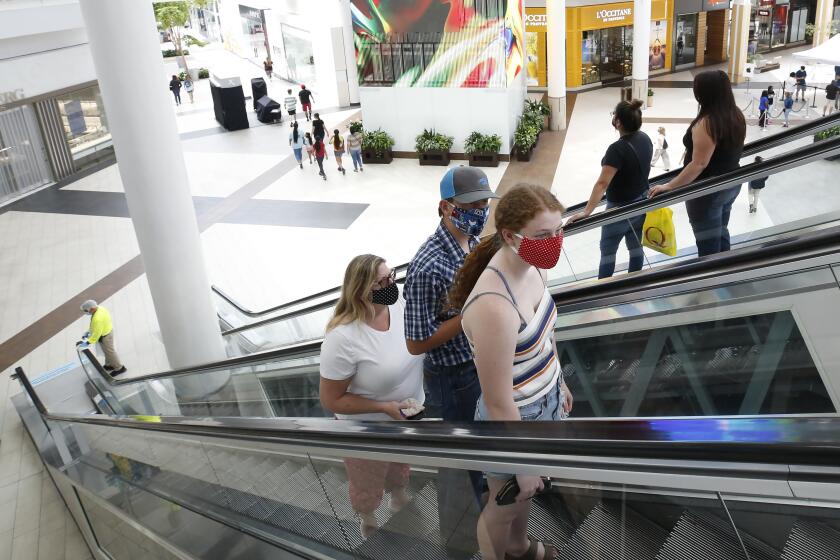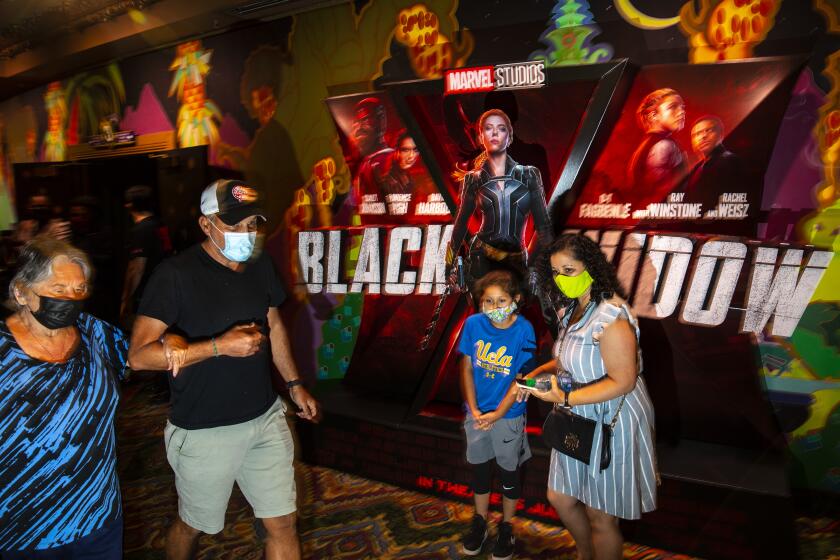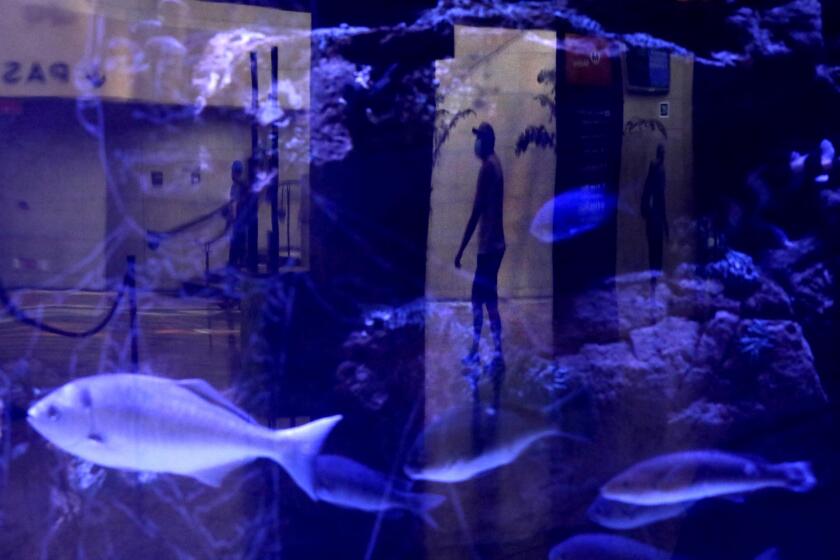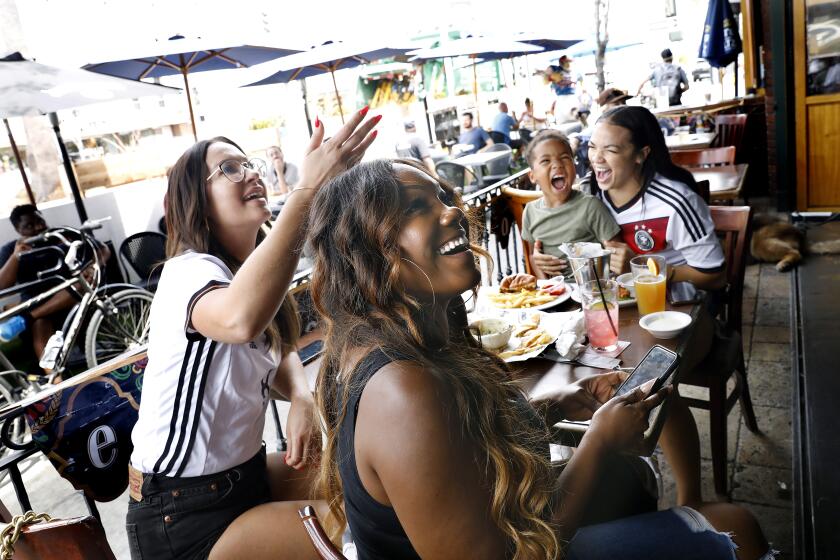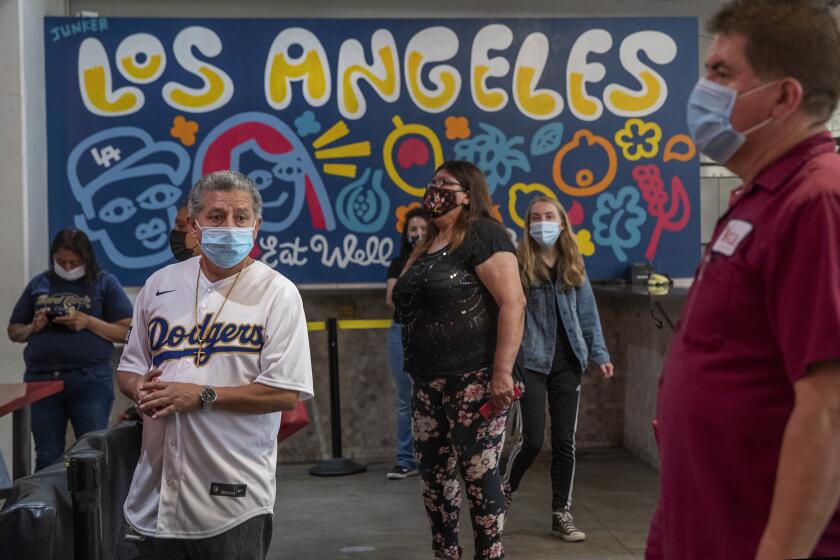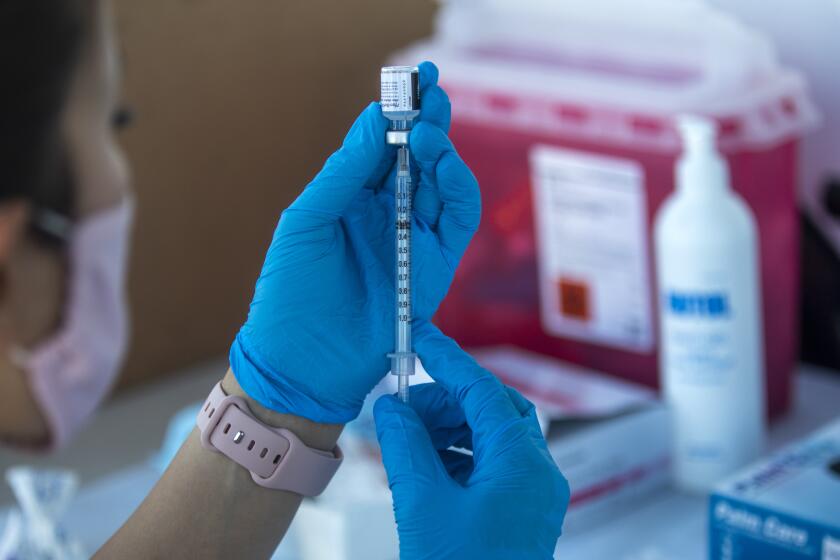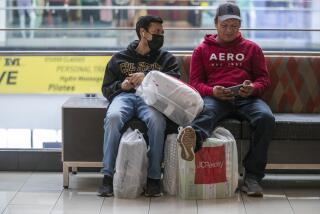Does L.A. County’s new COVID-19 mask mandate make any sense?
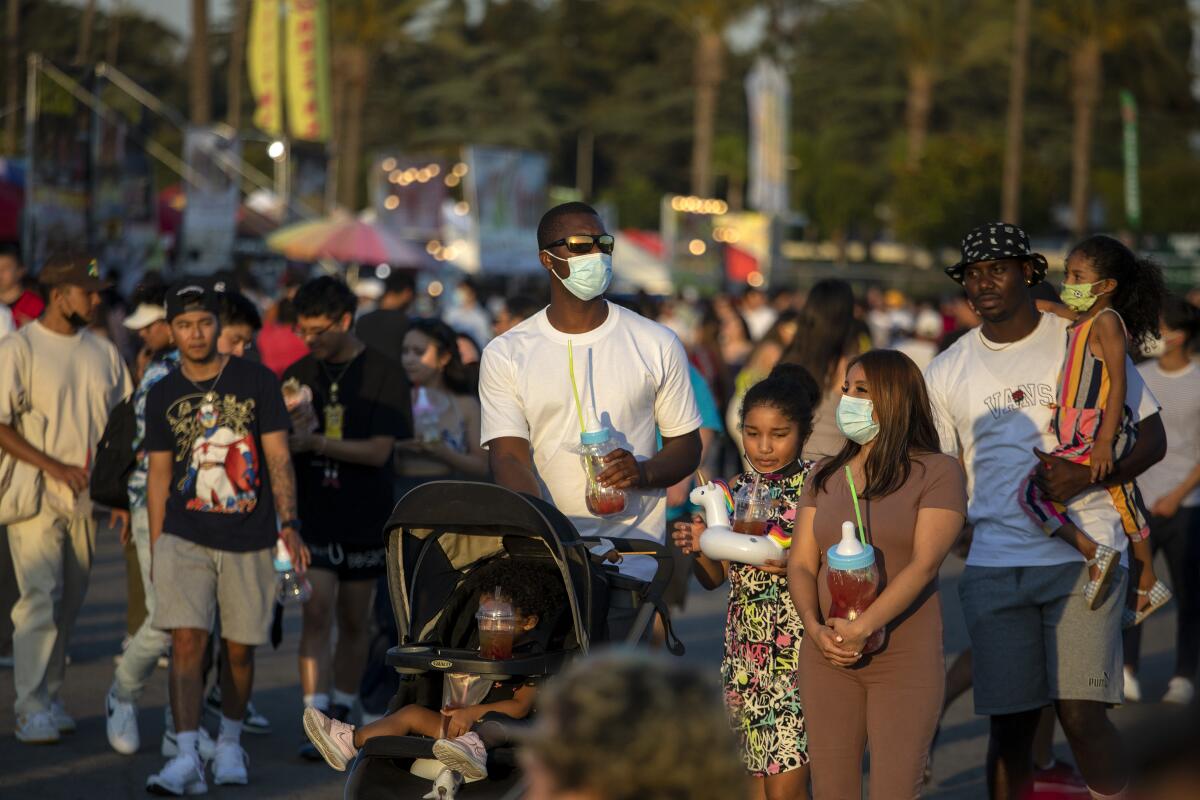
- Share via
Officials characterized Los Angeles County’s new mask mandate — requiring even vaccinated people to cover their faces indoors while in public — as a minimally disruptive, common-sense tactic to blunt rapidly rising coronavirus transmission.
But the fundamental question remains: Does it make sense?
After all, the latest health order, set to go into effect Saturday night, is at odds with guidance at the state and federal levels that fully vaccinated people need not wear masks because of the shots’ extraordinary effectiveness, while adding that local authorities are free to adopt a more stringent stance.
But L.A. County isn’t alone. Its posture is consistent with that of the World Health Organization, as well as the Israeli government.
And more entities are following suit: Seven counties in the San Francisco Bay Area on Friday recommended that everyone wear masks in indoor public areas. The counties that signed on the recommendation were San Francisco, Santa Clara, Alameda, Contra Costa, San Mateo, Sonoma and Marin.
They joined Sacramento and Yolo counties that made a similar recommendation earlier in the week. And UC San Francisco on Thursday implemented a campus-wide indoor mask mandate.
Yolo and Sacramento counties recommend keeping masks on while inside.
L.A. County officials say there’s a real need to take action now. Though infections and serious COVID-19 illness are still only a fraction of what was seen over the fall and winter, daily coronavirus cases are now six times what they were on June 15, when California fully reopened, and COVID-19 hospitalizations have doubled since then.
But the recent trends nonetheless represent a meaningful increase in the spread of the disease in the nation’s most-populous county.
Here are some key takeaways:
L.A. County’s community transmission levels have gone from ‘moderate’ to ‘significant’
The U.S. Centers for Disease Control and Prevention has a four-tier framework for assessing community transmission, with categories ranging from “low” and “moderate” to “substantial” and “high.”
According to a Times analysis of L.A. County’s daily case rate, the last time regional transmission would’ve been considered “substantial” or “high” was in March.
By June, L.A. County recorded its lowest daily case rate, calculated as an average over a seven-day period, since the early weeks of the pandemic — at just 11 weekly cases for every 100,000 residents. (By contrast, during its worst moments of the pandemic, L.A. County was recording more than 1,000 weekly cases for every 100,000 residents.)
But this week, L.A. County crossed back into the “substantial” category, and as of Wednesday night, was recording 75 weekly coronavirus cases for every 100,000 residents.
The CDC defines “high” community transmission as 100 or more weekly cases for every 100,000 residents.
Faced with a rise in coronavirus cases, L.A. County will again require residents to mask up in indoor public spaces — regardless of vaccination status.
Hospitalizations are rising
In an op-ed published in the Washington Post in April, three experts suggested that restrictions can lift once COVID-19 hospitalizations fall below 5 hospitalizations for every 100,000 residents. As a point of comparison, during the peak of the flu season, there’s an average of 20 to 40 hospitalizations for flu for every 100,000 residents.
The op-ed was penned by Syra Madad, senior director of the special pathogens program for New York City; Dr. Monica Gandhi, infectious diseases specialist at UC San Francisco; and, Dr. Ashish Jha, dean of the Brown University School of Public Health.
On Jan. 5, L.A. County hit a peak of 80 COVID-19 hospitalizations for every 100,000 residents. In mid-June, L.A. County hit a low of 2.1 hospitalizations per 100,000 residents.
The situation has backslid since. As of Wednesday, L.A. County was reporting 4.5 hospitalizations per 100,000 residents.
With new indoor mask mandate, L.A. County is asking the vaccinated to help the unvaccinated.
San Bernardino County has an even worse metric, with 6.1 COVID-19 hospitalizations for every 100,000 residents. In Sacramento County, there are 7.6 COVID-19 hospitalizations for every 100,000 residents.
L.A. County’s extensive hospital system is far from being overwhelmed, and officials don’t expect the hospitals will ever get as crushed with COVID-19 patients as they were during the winter surge.
Still, “the healthcare system could be significantly impacted if this continues,” Dr. Roger Lewis of the county Department of Health Services wrote in an email. “It is critically important that everyone eligible for vaccination who has not already been vaccinated does so as quickly as possible.”
Vaccination rates in L.A. County are respectable, but too low to hit ‘herd immunity’
California has one of the higher levels of vaccine coverage in the nation, and L.A. County’s rate is roughly in line with the state’s.
Still, that means L.A. County only has 60% of its population with at least one dose of vaccine, and 52% fully vaccinated. That’s still well below the estimated 70% to 85% that experts suspect is necessary to achieve “herd immunity,” in which ongoing disease transmission is stopped, even without the need for interventions like masking.
The mask rules will essentially revert back to where they were before the county lifted them prior to the June 15 reopening.
By contrast, San Francisco has 75% of its population with at least one dose, and 69% fully vaccinated. Northern California’s most populous county, Santa Clara, has 74% of its residents at least partially vaccinated, and 67% who are fully vaccinated.
Both Bay Area counties have had relatively stable hospitalizations in recent weeks. And Santa Clara County has only 2.7 COVID-19 hospitalizations for every 100,000 residents; San Francisco has 2.6.
L.A. County officials worry unvaccinated people stopped wearing masks
In reopening California on June 15, officials statewide implemented an honor system: unvaccinated people still had to wear masks in indoor public spaces, even though businesses were under no obligation to verify their inoculation status.
L.A. County officials are now worried that unvaccinated people instead responded by not masking up in required settings. And with cases and hospitalizations growing, authorities say they hope reinstituting masking as a social norm will help reduce disease transmission.
“We’re not where we need to be for the millions at risk of infection here in Los Angeles County, and waiting to do something will be too late given what we’re seeing now,” said Dr. Muntu Davis, the county’s health officer.
Officials have emphasized that fully vaccinated people have a very good chance of not being infected or becoming seriously ill if they are fully vaccinated. As of early July, unvaccinated people were being infected with the coronavirus in L.A. County at a rate five times higher than for those who had been vaccinated.
Despite the startling increases in new coronavirus infections and hospitalizations, officials stress that this uptick is different from earlier waves.
Some experts say the mask mandate is a reasonable option
“Hopefully, this will be the wake-up call for those who are still vaccine-hesitant to roll up their sleeves and get vaccinated,” said Dr. Robert Kim-Farley, medical epidemiologist and infectious diseases expert at the UCLA Fielding School of Public Health.
While he’s not concerned about the pandemic surging to the same kind of devastation seen half a year ago, he is “concerned about the trajectory and the speed of the doubling of new cases.”
“Once we can turn the corner again on this increase, I am confident the county will remove that mandate,” Kim-Farley said. “It’s just a matter of everyone playing their part.”
Gandhi, of UC San Francisco, agreed that vaccinated people masking indoors can be a reasonable policy decision if there are more than 5 people hospitalized for COVID-19 for every 100,000 residents.
Orange, San Diego and San Bernardino counties have all seen their daily case averages more than triple over the past two weeks.
Still, some experts question certain aspects of resuming a mask mandate
But Gandhi also said the approach to not require masking for vaccinated people — an idea promoted by the CDC and Dr. Anthony Fauci, the U.S. government’s leading infectious diseases expert — is sound and demonstrates to hesitant people the benefits they can enjoy after getting their shots.
“The White House task force strategy that they have outlined — which does not include putting masks back to the vaccinated — is scientifically sound,” she said.
Gandhi is also concerned that taking away the freedom for vaccinated people to be maskless could disincentivize hesitant people. A national survey by the Kaiser Family Foundation found that “a small but meaningful share said the easing of restrictions for vaccinated people made them decide to get a vaccine.”
It also makes little practical sense to order everyone to mask up in an office if everyone there is fully vaccinated, Gandhi said.
While some may fundamentally reject rolling up their sleeves for a shot, officials say there are many reasons why people may not have gotten vaccinated.
Vaccinated people benefit if there’s a lower community transmission rate
Whether you’re vaccinated or not, everyone benefits from a lower coronavirus transmission rate. If there’s very little circulating virus in a community, there is a much reduced risk.
“If there’s high levels of community transmission going on, we have to realize that we still could be a source of transmission to others,” Kim-Farley said. “We all have to play our part for the greater good of all.”
A lower community transmission rate also helps protect children under the age of 12, who are not yet eligible for vaccinations.
Davis, the L.A. County health officer, said “there’s still evidence that a very small number of fully vaccinated individuals” can be infected and actually might be able to pass along the virus to others.
Kim-Farley said “that’s another reason why I’m putting on the mask now.” It “is not so much out of concern that I will come down with disease, or severe disease, but that I still could then be a source of transmission to others — when there’s a large amount of community transmission going on.”
More to Read
Sign up for Essential California
The most important California stories and recommendations in your inbox every morning.
You may occasionally receive promotional content from the Los Angeles Times.
